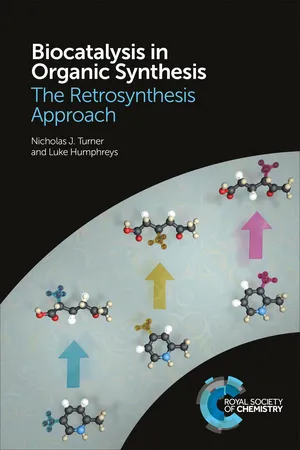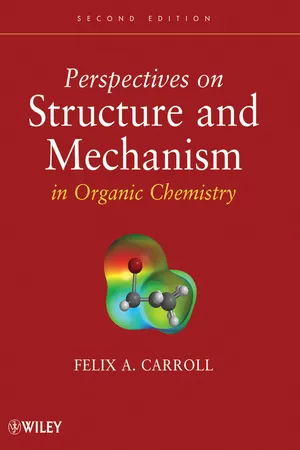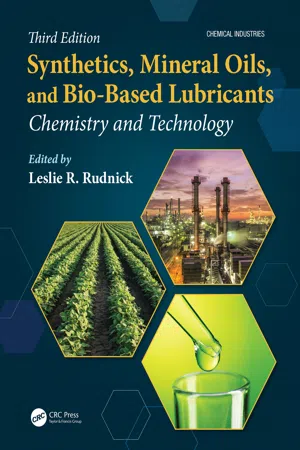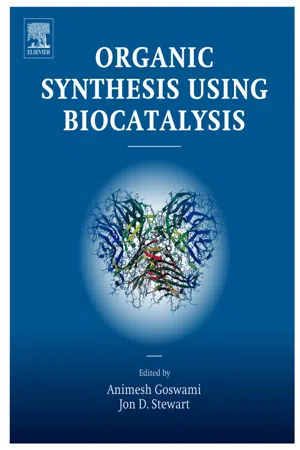Chemistry
Base Catalysed Ester Hydrolysis
Base catalysed ester hydrolysis is a chemical reaction in which an ester is broken down into its constituent alcohol and carboxylic acid components by the addition of a base. The reaction is typically carried out in the presence of water and a strong base such as sodium hydroxide. The process is commonly used in the production of soaps and detergents.
Written by Perlego with AI-assistance
Related key terms
Related key terms
1 of 4
Related key terms
1 of 3
4 Key excerpts on "Base Catalysed Ester Hydrolysis"
- eBook - ePub
Biocatalysis in Organic Synthesis
The Retrosynthesis Approach
- Nicholas J Turner, Luke Humphreys(Authors)
- 2018(Publication Date)
- Royal Society of Chemistry(Publisher)
Figure 3.2 , if we start with an ester, we can use a hydrolase and water to break the C–O ester bond to give a carboxylic acid and an alcohol.Figure 3.2 General transformation catalysed by hydrolases.This is exactly the same as if we had hydrolysed the ester chemically under either acidic or basic conditions. For acidic hydrolysis, we use a dilute acid such as hydrochloric acid to catalyse the reaction, whereas for basic hydrolysis we use hydroxide ions such as sodium hydroxide. These methods are easy to carry out, but we must be careful that the conditions of the hydrolysis reaction are compatible with the rest of the functional groups in the molecule, especially if we need to heat the reaction or use a strong acid or base. By comparison, enzyme-catalysed hydrolysis occurs under much milder conditions.There is also another advantage to carrying out a hydrolysis reaction using an enzyme: stereoselectivity. If we use a chiral ester as a substrate for the hydrolysis reaction, then the hydrolase enzyme will catalyse the reaction of one enantiomer of the ester faster than the other. This is because the enzyme itself is chiral and so will interact with enantiomers at different rates. As shown in Figure 3.3 , if we take a chiral ester that is a racemic mixture, then the hydrolase enzyme will hydrolyse one ester at a much faster rate, resulting in kinetic resolution.Figure 3.3 Kinetic resolution of an epoxide substrate catalysed by a hydrolase.In this particular example, we are interested in the chiral epoxide that is in the alcohol part of the ester that was hydrolysed. Instead of a racemic mixture of epoxides (which would be difficult to separate), at the end of the reaction we now have an ester and an alcohol, which we can separate easily.As we have already mentioned, both lipases and esterases will catalyse the hydrolysis of esters. However, when the ester is chiral, the two classes of enzymes prefer different substrates. As shown in Figure 3.4 - No longer available |Learn more
- Felix A. Carroll(Author)
- 2011(Publication Date)
- Wiley(Publisher)
158Acid-Catalyzed Hydrolysis of EstersFIGURE 7.15Catalysis of the hydrolysis of an ace-tal by 2-hydroxypyridine. (Adapted from reference 157.)The characteristic reaction of carboxylic acid derivatives is substitution, not addition, because the –OH, –OR, –NH2 , –X, –OCOR, and –SR groups are better leaving groups than are the hydride ions or carbanions that would be produced by the analogous substitution reaction of aldehydes or ketones.159 A general reaction is shown in equation 7.65 , where H–Nu is the protonated form of the nucleophile and L is the leaving group. These reactions can be catalyzed by both acid and base.160 Note that the hydrolysis of a carboxylic acid derivative with hydroxide ion consumes the hydroxide and generates a carboxylate ion. To the extent that carboxylate is a less effective base than hydroxide, catalyst is consumed during the reaction. To be precise, therefore, the process should be called base-promoted rather than base-catalyzed.(7.65)The mechanisms of acid-catalyzed hydrolysis of esters can also be categorized as A1 or A2. Two different pathways of each type can be defined, depending on whether the rate-limiting step involves cleavage of the acyl–oxygen bond (AAc 1 or AAc 2) or the alkyl-oxygen bond (AAl 1 and AAL 2).161 Only three of these mechanisms are common, however.112, 162 In the AAc 2 mechanism (acid-catalyzed, bimolecular, with acyl-oxygen cleavage) shown in Figure 7.16 , the rate-limiting step involves addition of water to the protonated ester.FIGURE 7.16AAc 2 mechanism for ester hydrolysis.The AAc 1 (acid-catalyzed, unimolecular, acyl-oxygen cleavage) mechanism is shown in Figure 7.17 . The reaction is unimolecular because the rate-limiting step involves dissociation of ROH from the protonated ester.112 - eBook - ePub
Synthetics, Mineral Oils, and Bio-Based Lubricants
Chemistry and Technology
- Leslie R. Rudnick(Author)
- 2020(Publication Date)
- CRC Press(Publisher)
Figure 3.1 ) and the ester products can in principle undergo hydrolysis, that is, reaction with water to regenerate the starting materials. In practice, this is rarely a problem in nonaqueous lubricant applications because at ambient temperatures the reaction rate constant is low and at elevated temperatures the residual concentration of water dissolved in the lubricant and available for reaction is low. However, an understanding of the fundamental processes involved in ester hydrolysis may be useful to prevent any potential problems developing.Hydrolysis occurs via an acid-catalyzed mechanism and the reaction rate is proportional to the concentration of water and the concentration of acid. A hydrogen ion adds to the carboxyl oxygen of the ester linkage, converting it transiently to a carbonium ion, which rapidly adds water to form a positively charged tetrahedral intermediate. This tetrahedral intermediate then separates into carboxylic acid and alcohol, regenerating a proton that can then catalyze further reaction. The reaction is therefore autocatalytic. The more acid that forms, the faster the breakdown, which in turn creates more acid. However, water is consumed in the reaction, which can only progress if more water is available [69 , 70 ].There are therefore two fundamental ways to control the rate of ester hydrolysis: reduce the water concentration or reduce the acid concentration. Other trace components such as residues of transition metal esterification catalysts may also act as catalysts and must be controlled, but unlike the acid, their effect is not autocatalytic [71 ].The rate of hydrolysis can in principle also be limited by restricting temperature, although this is not practically possible for most lubricant applications. Different ester structures have different inherent rates of hydrolysis. Aromatic esters and esters with branching at the 2 position of the acid group hydrolyze more slowly. - eBook - ePub
- Animesh Goswami, Jon D. Stewart(Authors)
- 2015(Publication Date)
- Elsevier(Publisher)
Chapter 5Hydrolysis and Formation of Carboxylic Acid and Alcohol Derivatives
Romas Kazlauskas Department of Biochemistry, Molecular Biology & Biophysics and The Biotechnology Institute, University of Minnesota, Saint Paul, MN, USAAbstract
Hydrolases are the enzymes most widely used for organic synthesis. The five most useful and commercially available hydrolases for organic synthesis are the lipases from Candida antarctica , from Candida rugosa and from Burkholderia cepacia , the esterase from pig liver and the protease subtilisin. Hydrolases accept a broad range of substrates, including many typical intermediates in organic synthesis. Beside hydrolysis of carboxylic acid derivatives in water or water–organic solvent mixtures, hydrolases also catalyze the formation of these derivatives in organic solvents. This chapter explains how to plan hydrolase-catalyzed reactions by choosing hydrolases and substrates that are likely to be resolved efficiently and where products are easily separated. Examples include kinetic resolutions (using hydrolysis or acylation), desymmetrizations of prochiral substrates, and dynamic kinetic resolutions.Keywords
lipase esterase protease hydrolysis transesterification vinyl esters kinetic resolution desymmetrization of prochiral substrates dynamic kinetic resolution1. Introduction – hydrolases commonly used in organic synthesis
Hydrolases catalyze cleavage of substrates by the addition of water. This chapter focuses on hydrolases that cleave carboxylic acid derivatives such as esters and amides: lipases, esterases, and proteases. By carrying out reactions in organic solvents without water, hydrolases can also catalyze acyl transfer reactions to make esters and amides.
Index pages curate the most relevant extracts from our library of academic textbooks. They’ve been created using an in-house natural language model (NLM), each adding context and meaning to key research topics.
Explore more topic indexes
Explore more topic indexes
1 of 6
Explore more topic indexes
1 of 4



